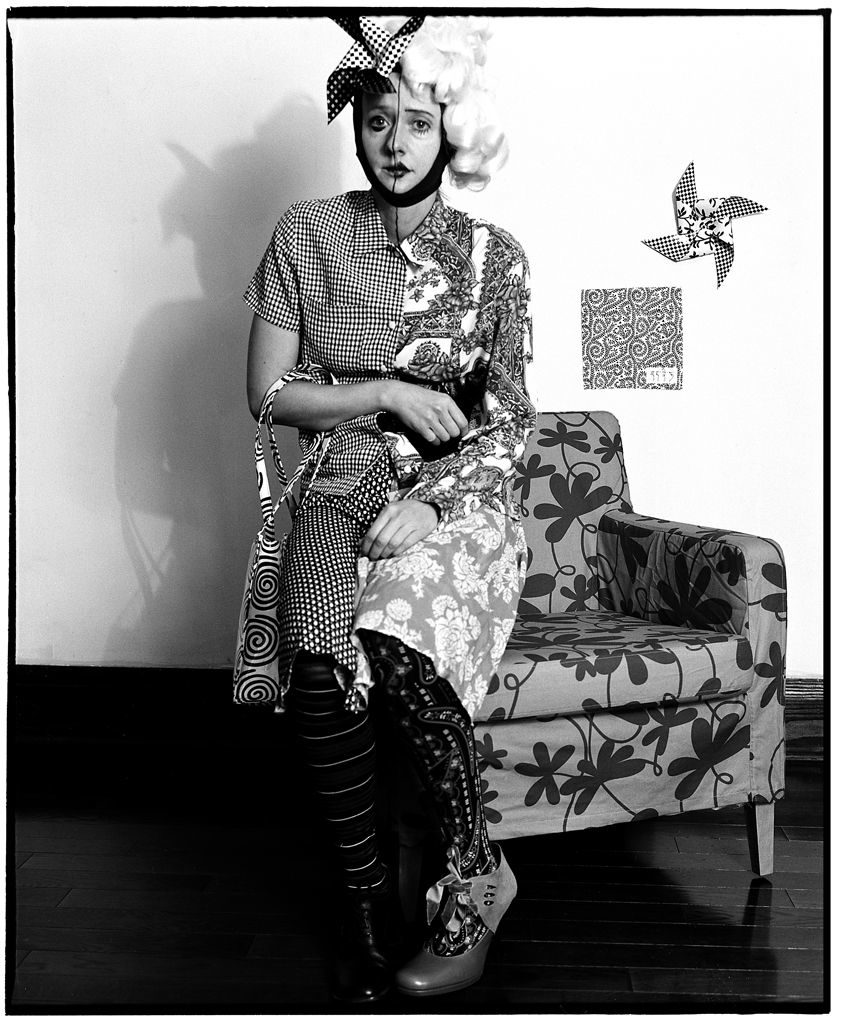One of the central assumptions in Western culture is the concept of identity and individualism. We have built legal edifices to individual human rights, entrenching the idea of the self. The Mute Book, Janieta Eyre’s photographic series recently exhibited at Katharine Mulherin Contemporary Art Projects, questions these suppositions in a uniquely poetic way.
Apparently, Eyre lost the ability to speak for three teenage years and realized that this made her all but invisible, as other people avoided interaction with her. The Mute Book draws inspiration from this personal history and the 17th-century Mutus Liber (Silent Book) of esoteric illustrations, an alchemical guide to transmutation. Metaphorically, Eyre’s series—which she says she may continue—suggests a process of self-enlightenment in images that also evoke the experience of birthing.
The first Mute Book image is quite subtle. Eyre photographs herself wearing an assortment of clothes that have been stitched together. A seam drawn through her face suggests different personalities, augmented by makeup that alters her features. She is perched on the arm of a chair that is floating above the floor. Floral patterns intersect with geometric designs. A pinwheel is fixed to the wall; its shape is echoed in the fascinator on one side of her head. A patterned square emphasizes flatness while her shadow contradicts this. She wears a black covering over her head that acts to disconnect head from body. Her hands are expressive as they hold the moment in abeyance.
The Mute Book #2 establishes a male/female duality via clothing and wedges the artist into a confined space, hinting at the need to grow.
The Mute Book #3 ventures into quantum mechanics, with mathematical formulas for matter scrawled on a blackboard. Eyre has drawn esoteric symbols on her body and her eyes are masked like a raccoon’s. A cage references containment while books seem to offer solutions. She is questioning objective reality with all the dark matter still hidden and unquantifiable. How do we grasp identity when so much is in flux? Only as a fabrication.
The next stage in enlightenment, some say, is equated with the third eye opening and ascension, or flying. The Mute Book #4 moves into a patterned zone that is simultaneously two- and three- dimensional. Eyre is slouched and withdrawn behind rope lines, wearing stockings. The action of enlightenment takes place within passivity and relaxation. A nonsensical calendar evokes significant dates as the artist withdraws from her physical presence.
Gestation is referenced in The Mute Book #5. Eyre is poised, still mute to utter “the word,” which can mean “the birth” in certain alchemical texts. Arcane diagrams mark the journey behind her. One hand is on her breast and the other on a cup, symbolizing nurturing. The sitting pose links to the adding machine at her feet, flowing these codes through her body, making her into a cipher.
The Mute Book #6 references birth through a Miro-esque figure in mitosis and a checkerboard populated with mirrored gene-sequence “words” or codes. The artist’s body has become translucent and immaterial, a pattern for a “dress.”
The Mute Book #12—the most recent work on display from the series—has further arcane diagrams suggestive of trees growing down and up, perhaps unifying realms. Eyre holds segments of torn paper in her hands and gazes through a single spectacle over one eye. The umbilical cord is severed.
The dense hermeticism in Eyre’s vision generates a fascinating journey for the viewer, rewarded with a glimpse into a very complex psyche. This is a magnificent body of work.









